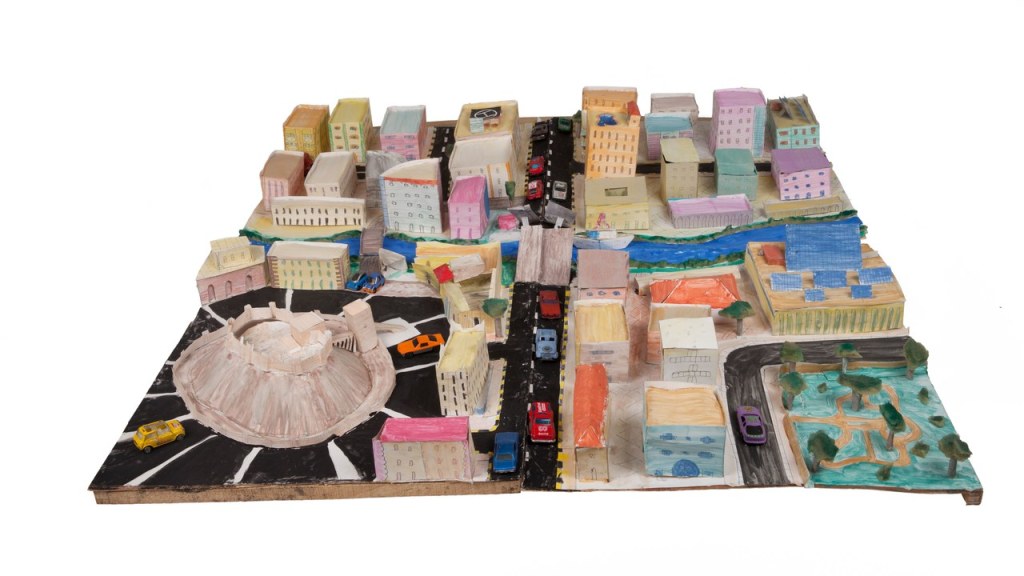電梯井中的博物館

|
在這個位于紐約市中心無名小巷的六英尺乘六英尺的電梯井中,探索者們將發(fā)現(xiàn)一批正在委內(nèi)瑞拉共享空間中銷售的假冒產(chǎn)品,例如仿制的自制防毒面具,大多由中東人制作,還有可以實現(xiàn)宗教現(xiàn)代化的物件。(例如無谷圣餐餅、咒語計數(shù)器、安息日燈開關(guān)保險和LED焚香棒。) 為了防止人們誤會,有一件事情我們得明確:擺放在這里的物品看似雜亂無章,但它們并非是無的放矢。此外,這個電梯井實際上是一個博物館。 Mmuseumm由亞歷克斯·卡爾曼和幾位好友于2012年創(chuàng)建,同時會舉辦8到15個展覽,每年共展出約150件精心挑選的物件。每個展覽都有一個架子,上面展示著乍一看隨機擺放的物件。卡爾曼說,這個空間在每年4月至11月對外開放,擺滿了“能夠洞悉我們所居住世界的本土物件。”他將Mmuseumm看作是“物品新聞”的載體。 他說的這句話到底是什么意思?他解釋說:“[我正在]嘗試通過物品來審視我們自身的本質(zhì)以及所居住的整個世界。我認為這些物品所提供的視角能夠讓我們從內(nèi)心出發(fā),以真誠的態(tài)度近距離審視這個問題。” 館長選擇的地點在一定程度上也體現(xiàn)了這個視角。這位34歲的館長自2014年一直就是Mmuseumm的唯一所有者,他說:“我認為,就像物品自身一樣,它們在某種程度上十分低調(diào),而且也不起眼,我希望這個空間也能夠具備這些特質(zhì)。我想要的是一個意想不到的場地。我希望人們需要花點時間才可以找到這個地點,這樣,人們的好奇心就會被調(diào)動起來。”總而言之,這里的一切都不是隨意擺放的,即便是博物館頗為奇怪的名字亦是如此。 博物館現(xiàn)任設(shè)施經(jīng)理凱特·阿托爾說:“一開始的幾個季度,我們將這里稱之為museum(博物館)。我們希望按其本來的面目來給它起名字。”最終,卡爾曼力求突出“Mmuseumm的荒誕性”,因此在museum的前面增加了字母m。為了對稱,他又在名字的結(jié)尾加了另一個m。然而,卡爾曼說:“我不會去糾正其他人以及他們的各種念法。” 將形態(tài)與功能以如此無縫的形式結(jié)合起來是一項難得的壯舉。然而在這里,這個理念是可行的,尤其是在談到今年的展覽時更是如此。例如,看起來像是隨機擺放在其中一個架子上的15個熱面包復(fù)制品實際上是對當前監(jiān)獄系統(tǒng)的拷問,它講述了一位男囚的故事,他被獨自關(guān)在利克斯島(Rikers Island)上,然后他決定在小賣部購買一些甜品來自殺。在吃了所有的甜品之后,他因為糖尿病而昏了過去,然后去世了。自此以后,小賣部不再出售熱面包。 卡爾曼在介紹其理念時表示:“最終,展覽真的必需具備實質(zhì)性的內(nèi)容。”他覺得,那些不同尋常的空間(這個地方是他偶然發(fā)現(xiàn)的,他的辦公室就在樓上,房東把廢棄的電梯井讓給了他)只能講述他希望分享的故事,但并非是故事本身。他在談到貨梯時表示:“不能只是徒有其表,整個展覽的不同尋常之處在一定程度上以自身的美學反映了這些非常傳統(tǒng)的博物館元素:架子上的紅色天鵝絨、白色的模具。說到博物館體驗,我們遵循了一定的規(guī)則,為的是打破很多規(guī)則。” 很明顯,卡爾曼認為他的理念可以在曼哈頓和這個狹小的電梯井空間之外引發(fā)共鳴。這一點他并沒有錯:此前在Mmuseumm展出的兩件作品如今正在全球旅行。“薩拉·博曼的壁櫥”(2015)再現(xiàn)了卡爾曼祖母84歲去世之時的壁櫥,曾經(jīng)于2017年在紐約大都會藝術(shù)博物館展出,并于2018年搬至洛杉磯的史克博爾文化中心(Skirball Cultural Center),如今已經(jīng)成為了費城獨立廣場美國猶太歷史國家博物館門外象征自由與獨立的公共紀念物。2016年在Mmuseumm首次展出的“我的阿勒頗”是一個4英尺乘4英尺的敘利亞城紙質(zhì)模型,源于戰(zhàn)爭期間14歲男孩默罕默德·酋塔西的想象。該作品隨后現(xiàn)身于史克博爾文化中心(2017年)和倫敦的維多利亞與阿爾伯特博物館(2018年),如今正在斯德哥爾摩的ArkDes博物館展出。 |
Inside a six-by-six-foot elevator shaft in a nondescript alley in downtown New York City, explorers will find a bunch of counterfeit products currently being sold in Venezuela sharing space with facsimiles of homemade gas masks created by, mostly, Middle Easterners, alongside gadgets seeking to modernize religion. (Think gluten-free Communion wafers, a mantra counter, a safe-for-the-Sabbath light switch, and LED incense sticks.) Lest you be confused, let’s make one thing clear: The seemingly haphazard collection of objects is meant to be here. Also, the elevator shaft is actually a museum. Founded by Alex Kalman and a few friends back in 2012, Mmuseumm displays between eight and 15 exhibitions simultaneously, collectively showcasing about 150 curated items annually. Each exhibit consists of a shelf parading a slew of at-first-glance random objects. Open every year from April through November, the space is “filled with vernacular objects that provide insight into the world that we’re living in,” says Kalman, who sees Mmuseumm as a purveyor of “object journalism.” What, exactly, does he mean by that? “[I am] trying to look at who we are and the world that we’re living in through objects,” he explains, “believing they provide a very intimate, visceral, honest perspective.” Part of that perspective is manifested through the curator’s chosen venue. “I think that, like the objects themselves, which are in some way kind of humble—[they] are things that don’t call out for our attention—I wanted the space to also be that,” says the 34-year-old, who has been the sole owner of Mmuseumm since 2014. “I wanted an unexpected location. I wanted you to have to kind of find it, and in doing so, you’d already get into the mindset of being curious.” In essence, nothing here is random—not even the museum’s fairly odd name. “The first couple of seasons we were called Museum,” says Kate Athol, the current facilities manager. “We wanted to call the thing what it is.” Kalman eventually sought to highlight “the absurdity of what Mmuseumm is” and so added an “m” at the beginning of the name. For symmetry, he opted to add another one at the end of it. But, Kalman says, “I don’t correct other people and their various pronunciations.” It’s a rare and incredible feat for form and function to coalesce so seamlessly. But here, the concept works—especially when analyzed against the backdrop of this year’s exhibitions. The 15 hot bun reproductions that appear to be placed at random on one of the shelves, for example, are actually a commentary on the current prison system, recounting the story of a man locked in solitary on Rikers Island and his decision to purchase the treats at the commissary as a way to commit suicide. Consuming them all at once, he went into a diabetic coma and passed. Hot buns are no longer sold at the commissary. “Ultimately, there really does need to be substance,” Kalman says of his concept. He feels that the unusual space—which he found serendipitously; his office was upstairs, and the landlord offered him the shaft when no longer in use—only contributes to telling the stories he wishes to share, but isn’t the story itself. “It can’t just be style,” he says of the freight elevator. “The unconventionality of the whole thing in some ways refers to these very traditional museum elements within its aesthetic: the red velvet on the shelves, the white molding. We’re following some rules so we can break many others when it comes to what a museum experience can be.” Clearly, Kalman believes his concept could resonate both outside Manhattan and outside a tiny elevator shaft. And he isn’t wrong: Two of the exhibits previously mounted at Mmuseumm are now traveling the world. “Sarah Berman’s Closet” (2015)—a reproduction of Kalman’s grandmother’s closet at the time of her passing, when she was 84—was on display at New York’s Metropolitan Museum of Art in 2017, moved to the Skirball Cultural Center in Los Angeles in 2018, and is currently a public monument to freedom and independence outside the National Museum of American Jewish History at Philadelphia’s Independence Mall. “My Aleppo,” which debuted at Mmuseumm in 2016, is a four-by-four-foot paper model of the Syrian city as imagined by Mohammed Qutaish, a 14-year-old boy, during the war. It traveled to the Skirball Cultural Center (2017), the Victoria and Albert Museum in London (2018), and is currently on display at ArkDes, in Stockholm. |

|
卡爾曼說:“對我來說,Mmuseumm是一個實驗這種敘事手法的場地。在這里展出之后,我們會舉辦展品巡展活動。”這些海外展出獲得的費用,Mmuseumm建議的4美元捐贈費以及一系列來自于個人的捐贈為這個非營利性博物館提供了財力支持。此外,離該電梯井僅有數(shù)步之遙的地方,參觀者可以在Mmuseumm Alley這個小禮品店購買零食、咖啡、紀念品和限量收藏品。 阿托爾稱,每年有數(shù)千名參觀者到訪Mmuseumm,他們有的住在這個地區(qū),有的是上班路過,有的則是從新聞和旅游指南中看到了這則新聞,還有的則屬于狂熱的粉絲,他們每年都會定期長途跋涉趕來參觀當年的展覽。館長說,到了這里之后,“人們似乎異常感動,有一位參觀者說,他們喜愛這里的真正原因在于,博物館不會去固化他們的想法,而是給他們自由的思考空間。” 當然,卡爾曼希望以一種意料之中的意外方式來擴大其項目的規(guī)模,從而提升該項目的反響。他在談?wù)撐磥碛媱潟r說:“這個方案最吸引我的地方在于,它不是將展覽場地擴大,而是將其打造為一個由眾多小型場地組成的展覽網(wǎng)絡(luò)。這是一個去中心化的博物館,其中涵蓋設(shè)在全球其他國家的場地。” 他說,畢竟,“常規(guī)性的做法真的很無聊。”(財富中文網(wǎng)) 譯者:馮豐 審校:夏林 |
“Mmuseumm is a place for me to experiment in this form of storytelling,” Kalman says. “After being exhibited here, we could tour the exhibitions.” Fees from these foreign shows, a suggested $4 contribution at Mmuseumm, and a series of donations from private individuals financially support the destination, which is run as a nonprofit. Also, just a few feet away from the shaft, visitors can purchase small bites, coffee, souvenirs, and limited-edition collectibles at Mmuseumm Alley, a tiny gift shop. According to Athol, the tens of thousands of folks who visit Mmuseumm each year either live in the area, walk by on their way to work, read about it in the news or guidebooks, or are ardent fans that make an annual pilgrimage to check out the year’s exhibitions on a regular basis. Upon entering the premises, “people seem to be incredibly moved,” the curator says. “One person said that what they really love about it is, it doesn’t tell them what to think, but that thinking is what they should be doing.” Of course, Kalman hopes to replicate that kind of reaction by expanding the scope of his project in—unsurprisingly—unexpected ways. “What attracts me most,” he says when queried about future plans, “is expanding not as one larger space but as this network of smaller locations. Kind of a decentralized museum that will include locations in other countries in the world.” After all, he says, “regular really bores me.” |













